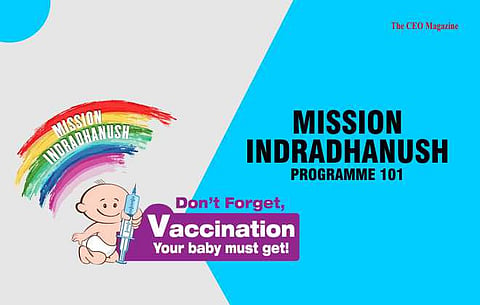
- News
- Women
- Magazine
- IndustryIndustry
- InsightsInsights
- Success Stories
- PublishPublish
- ContactContact
- Media KitMedia Kit

MISSION INDRADHANUSH PROGRAMME 101
MISSION INDRADHANUSH PROGRAMME 101
If you wonder where can I receive information about the vaccination for children in India?
Well, the National Health Portal of India, Mission Indradhanush is the answer.
India is now a polio-free country after decades of this disease impacting thousands of citizens. Now, the government has ensured vaccination for diseases like the same to reach every child.
Mission Indradhanush was launched by the Ministry of Health and Family Welfare, Government of India on December 25, 2014, was targeted to cover unvaccinated, or partially vaccinated against vaccine-preventable diseases by 2020.
In 1978, an expanded programme on immunization was launched which was followed by the Universal Immunisation Programme (UIP) offering free vaccines against 12 life-threatening diseases, to 26 million children annually.
Now, many confuse between Mission Indradhanush and UIP and the difference between both is of course there launch dates, the number of vaccines they offer which is 12 for UIP, while MI offers 7 vaccines.
If you need more details about the Universal Immunisation Programme (UIP) from Ministry of Health and Family Welfare.
So, the implementation of Mission Indradhanush was essentially like a "catch-up" campaign focused and systematic immunization drive where the aim was to cover all the children who have been left out or missed out for immunization.
Along with the pregnant women who were administered the tetanus vaccine, ORS packets and zinc tablets are distributed for use in the event of severe diarrhoea or dehydration and vitamin A doses are administered to boost child immunity.
The mission worked in phases covering the areas under focus targeting 201 high priority districts in the first phase, 297 districts for the second phase in the year 2015 and 216 districts in the third Phase during 2016.
The implementation within the districts was focussed on high-risk settlements identified by the polio eradication programme.
The pockets with low coverage due to geographic, demographic, ethnic and other operational challenges that showcased as most of the unvaccinated and partially vaccinated children concentrated in these areas.
High-risk areas identified by the polio eradication programme include populations living in areas such as:
Other migrants (fisherman villages, riverine areas with shifting populations etc.) and
Underserved and hard to reach populations (forested and tribal populations etc.)
Areas with low routine immunization (RI) coverage (pockets with Measles/vaccine-preventable disease (VPD) outbreaks).
Areas with vacant sub-centres: No ANM posted for more than three months.
Areas with missed Routine Immunisation (RI) sessions: ANMs on long leave and similar reasons
Small villages, hamlets, dhanis or purbas clubbed with another village for RI sessions and not having independent RI sessions.
The second round of Intensified Mission Indradhanush 2.0 or IMI 2.0 as a flagship scheme was launched at the block level in 35 districts of Uttar Pradesh on January 6, 2020.
The vaccination programme under Intensified Mission Indradhanush 2.0 focused on achieving 90 per cent vaccination coverage among children below the age of 2 years was aimed to be carried out in four rounds over seven working days excluding the regular immunisation days, official holidays and Sundays between December 2019 and March 2020.
The first round was completed in December 2019 and the second is currently underway. The third and fourth round of the mission will be launched in February and March 2020.
The government's main objective is to achieve full immunisation coverage across 272 districts of 27 Indian states under the mission.
• In Uttar Pradesh, the third and fourth rounds of the mission will cover 425 blocks of 73 districts in the state whereas in Bihar, the mission has been launched to cover low immunization pockets of the state covering children up to the age of 2 years and all pregnant women.
The Intensified Mission Indradhanush (IMI) 2.0 is the successor to the Intensified Mission Indradhanush (IMI), which was launched by Prime Minister Narendra Modi on October 8, 2017, to further intensify India's immunisation programme.
The key objective behind the launch of the intensified immunisation drive was to ensure that no child suffers from any vaccine-preventable diseases. Hence a 7-day immunisation drive was conducted every month starting from October 2017 till January 2018 in 173 districts and 17 cities.
Along with the programme aiming to cover the low performing areas in the selected districts (high priority districts), it also covers urban areas with special focus on the unserved and low coverage pockets in urban slums with a migratory population.
One of the keys highlighted points of the Mission Indradhanush 2.0 programme is focus on improving immunisation coverage in select districts and cities to ensure 90 per cent coverage of full immunisation by December 2018.
The IMI programme was monitored by the Cabinet Secretary at the national level. It was also supported by 12 ministries and departments.
Follow us on Google News
